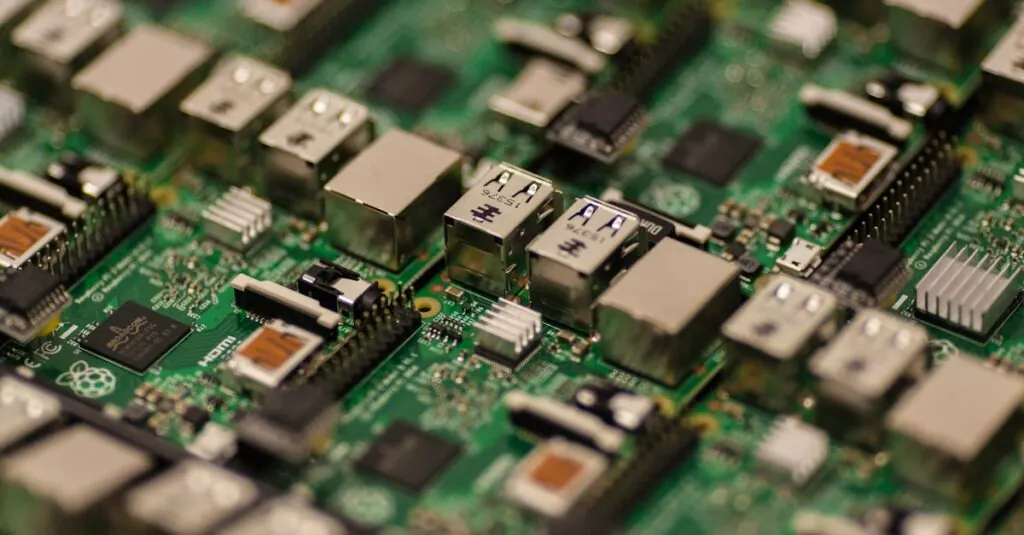Table of Contents
ToggleIn a world where streaming cat videos and online shopping reign supreme, a reliable internet connection is no longer a luxury—it’s a necessity. Enter DSL, the unsung hero of the broadband world. With its ability to deliver high-speed internet over existing phone lines, DSL is like that dependable friend who always shows up on time, even when the Wi-Fi gods seem to be on vacation.
While fiber optics may be the flashy new kid on the block, DSL offers a practical solution for those who want speed without the premium price tag. It’s perfect for households where everyone’s streaming, gaming, and scrolling simultaneously. So, if you’re tired of buffering and dropped connections, it might be time to give DSL a shot. After all, who wouldn’t want a connection that’s as reliable as your morning coffee?
Overview of DSL Connection
DSL, or Digital Subscriber Line, offers high-speed internet access via existing phone lines. This technology utilizes different frequencies on the line, allowing voice and data to transmit simultaneously. Users benefit from faster download speeds compared to traditional dial-up connections.
Typically, DSL connections range from 1 Mbps to 100 Mbps. The specific speed varies based on factors like distance from the provider’s central office and the service plan selected. Many households, with multiple users streaming movies or engaging in online gaming, find these speeds adequate.
Installation of a DSL connection requires minimal equipment. A DSL modem connects to the phone line, enabling internet access. Some providers offer bundled services, combining DSL internet with phone and television options, further enhancing value.
Moreover, DSL maintains a constant connection, differing from cable internet during peak usage times. While cable speeds can fluctuate, DSL provides consistent performance for everyday activities. This reliability makes DSL an attractive option for users who depend on steady connectivity.
In terms of cost, DSL remains competitive when compared to fiber and cable alternatives. Many providers offer various plans to suit household needs and budgets. For customers frustrated with buffering or connection drops, switching to DSL may improve their online experience significantly.
How DSL Connection Works
DSL connections utilize existing phone lines to deliver high-speed internet access, ensuring reliable and consistent connectivity. Various technologies and modulation techniques contribute to its effectiveness.
Digital Subscriber Line Technology
Digital Subscriber Line technology employs multiple frequency bands to transmit voice and data simultaneously. This separation allows users to make phone calls while browsing the internet. DSL offers various types, such as ADSL and VDSL, each providing different speeds and capabilities. ADSL (Asymmetric Digital Subscriber Line) focuses on faster download speeds, while VDSL (Very High Bitrate Digital Subscriber Line) accommodates higher bandwidth for more demanding applications. Speed ranges typically vary from 1 Mbps to 100 Mbps, depending on the distance from the service provider’s central office and specific service plans. Users benefit from seamless performance, particularly when engaged in activities like streaming and gaming.
Modulation Techniques
Modulation techniques enhance DSL performance by converting digital data into signals suitable for transmission over phone lines. Discrete Multitone Modulation (DMT) stands out as a prevalent method. DMT divides the available bandwidth into multiple channels, enabling simultaneous data transfer. Each channel carries a portion of the data, optimizing overall speed and reliability. Another technique, Quadrature Amplitude Modulation (QAM), modifies the signal further, contributing to improved data transfer rates. These advanced modulation methods ensure users experience a stable connection, reducing interruptions during peak usage times.
Advantages of DSL Connection
DSL connections offer several benefits, particularly for users who prioritize reliability and consistent performance.
Speed and Performance
DSL delivers impressive speeds, typically ranging from 1 Mbps to 100 Mbps. Many users experience stable connections that support multiple devices simultaneously. Speed depends on the distance from the provider’s central office; closer proximity often results in better performance. Activities such as streaming or online gaming work smoothly without noticeable buffering. Technologies like ADSL and VDSL cater to specific user needs, optimizing bandwidth and speed ratios.
Availability and Accessibility
DSL’s widespread availability makes it an accessible option for many households. Users benefit from existing phone lines, eliminating the need for new infrastructure. Rural and suburban areas often enjoy better access compared to fiber options, which may not reach all locations. Numerous service providers offer DSL plans, ensuring various budget options are available. Additionally, convenient bundling with phone and television services attracts many users looking for comprehensive solutions.
Disadvantages of DSL Connection
Several drawbacks accompany DSL connections. These issues can impact overall performance and user experience.
Signal Degradation
Signal degradation poses a significant challenge for DSL users. As the distance from the provider’s central office increases, the connection quality diminishes. Users notice slower speeds and occasional drops in service as a result. Moreover, factors like line interference and weather conditions can further weaken signals. These issues reduce the effectiveness of DSL, especially for households requiring stable internet for activities like streaming or online gaming.
Limited Bandwidth
Limited bandwidth restricts the number of users and devices that can effectively connect. Unlike fiber optics, which supports greater data throughput, DSL bandwidth often lags behind, especially with multiple users. Households with various devices streaming or gaming simultaneously may encounter slowdowns. Speed tiers offered by providers vary, but basic DSL plans frequently don’t meet higher bandwidth demands. Consequently, users might find themselves faced with congested connections during peak usage hours, leading to frustration and unreliable performance.
Comparing DSL Connection with Other Internet Options
Understanding the differences between DSL and other internet options helps users make informed choices. DSL competes directly against cable and fiber optic connections, each offering unique benefits.
DSL vs. Cable
DSL delivers stable speeds and consistent performance, especially during peak usage times. In contrast, cable internet often faces significant slowdowns when many users access it simultaneously. Users can experience faster upload speeds with cable, but this advantage may not offset DSL’s reliability for multi-user households. Additionally, DSL uses existing phone lines, making it more accessible in rural areas where cable might not be available. Lower monthly costs also make DSL appealing for budget-conscious consumers.
DSL vs. Fiber Optic
DSL typically offers lower speed ranges compared to fiber optic connections. Fiber optic technology can reach speeds upwards of 1 Gbps, providing a substantial advantage for heavy internet users. Although fiber optics enables superior data transfer rates, installation costs and availability can limit access for many households. DSL remains a more economical choice with plans that fit various budgets, especially beneficial for users who primarily engage in routine activities like browsing and streaming. While fiber is faster, DSL’s reliability and cost-effectiveness make it a solid option for many users.
Conclusion
DSL connections offer a reliable and cost-effective solution for households seeking stable internet access. With the ability to support multiple devices simultaneously and deliver consistent performance, DSL stands out as a practical choice for users engaged in streaming and gaming. Its straightforward installation and widespread availability make it accessible for many, particularly in areas where fiber optics may not reach. While there are some limitations regarding speed and distance, DSL remains a strong contender in the internet service landscape. For those looking to enhance their online experience without breaking the bank, DSL could be the ideal option.




